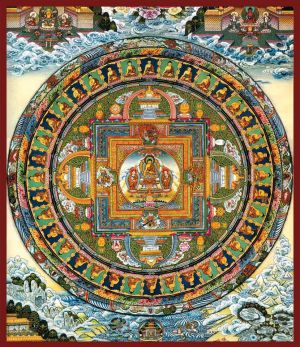The samaya vows and the Nyingma
All higher tantric empowerments bind those who receive them with serious vows, known as samaya vows. In the Nyingma school, there are 28 samaya vows, divided into three root vows and 25 branch vows.
The three root vows are:
(i) The vow of the body: to venerate the guru
(ii) The vow of speech: to continually practice the mantras and mudras of the deity
(iii) The vow of mind: to keep the restricted teachings of the tantras secret.
The other 20 vows are placed in four groups:
(i) The five to be accepted
(ii) The five not to be rejected
(iii) The five to be practised
(iv) The five to be known
(v) The five to be accomplished
Now, like most things Nyingma, the authenticity of these 28 vows has been called into question by representatives of the other Tibetan schools, who generally follow a system of 14 samaya vows. In response to this, it should be pointed out that arrangements of the samaya vows similar to the Nyingma 28 are found in the Guhyagarbha tantra and in Vilāsavajra’s Exposition of the Samaya. Similar but not identical; the
Guhyagarbha as 20 vows, and Vilāsavajra gives 29. For an identical set of 28 vows, we need to go to the Dunhuang manuscripts. At least two of these manuscripts (probably 10th century) explain the samaya vows in the almost exactly the same way as the later Nyingma tradition. The presentation is perhaps not as clear as it might be, but I will quote from one of them, IOL Tib J 436 (folios 1v to 2r):
What are the relevant samayas?” In order to strive in that which is concordant and to restrain that which is discordant, in order to obtain and accomplish, one should take build up the samayas. There are twenty-eight samayas; this is the oral transmission (lung). According to the esoteric instructions (man ngag) they are grouped into three. This one should know.
What are they?” They are (i) the samaya of view, (ii) the samaya of practice and (iii) the samaya of accomplishment. Now to distinguish these. The samaya of mind (not disseminating the secret instruction to others) and the five aspects to be known are the samaya of the view. The samaya of the body (not developing
animosity or scorn towards the vajra master and brothers and sisters), the five samayas to be practiced and the five samayas not to be renounced are the samaya of practice. The samaya of speech (not stopping the mantras and mūdras) and the five samayas to be accomplished are the samaya of accomplishment. The result of these three is the nature of accomplishment.
Note how this passage parcels up the samaya vows into another set of divisions:
(i) The samaya of the view.
(ii) The samaya of practice.
(iii) The samaya of accomplishment.
References
1. Dorje, Gyurme. 1987. The Guhyagarbhatantra and its XIVth Century Tibetan Commentary, phyogs bcu mun sel. Ph.D. thesis, the School of Oriental and African Studies, University of London.
2. Dorje, Gyurme. 1991. “The rNying-ma interpretation of commitment and vow.” In T. Skorupski (ed.) The Buddhist Forum, vol.II. London: SOAS.
Tibetan sources
1. Gsang ba’i snying po de kho na nyid nges pa [[[Guhyagarbha tantra]]]. Tb.417.
2. Vilāsavjara. Dam tshig gsal bskra [[[Exposition]] of the Samaya]. Q.4744.
Source
[[1]]
